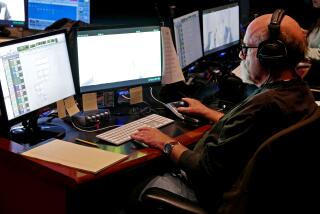Bin Laden Tapes Raked for Inadvertent Leads
- Share via
WASHINGTON — Students of Osama bin Laden at the CIA got more homework Monday.
Another tape thought to be from the terrorist leader, this one urging a boycott of Iraqi elections, was the sixth audio or videotape from Bin Laden since September. It was more grist for a battery of CIA analysts who have been scouring the recordings for fresh clues about the Al Qaeda mastermind.
Much of the effort has focused on studying the statements for new insights into Bin Laden’s intentions. But U.S. intelligence officials say that with each new tape there is a parallel and equally energetic effort to examine every aspect of the recording for inadvertent leads on matters ranging from Bin Laden’s whereabouts to his health.
The effort has been growing in intensity, fueled by swelling budgets and payrolls since the Sept. 11 attacks on the United States. And there have been some small successes, said current and former intelligence officials familiar with the efforts. But until Bin Laden is killed or captured, the true payoff remains elusive.
The CIA has tapped geologists to examine rock formations seen in the background of Bin Laden’s tapes, and has turned to botanists for help in identifying trees or shrubs, all in an effort to detect any unique stones or flora that could yield clues to his location.
The agency has enlarged images of the maps used as backdrops in some videotapes to scan for telltale markings. Analysts have argued about whether Bin Laden wore a certain knife to send a coded message to operatives. And CIA psychiatrists and doctors have studied Bin Laden’s appearance and mannerisms for clues about possible psychological irregularities and the extent of his reported ailments.
The effort is not confined to U.S. intelligence. German authorities thought they heard a bird chirping in one of Bin Laden’s audiotapes this year, and brought in ornithologists to identify the species -- and its habitat -- according to reports in the German media. They did identify the bird, a source said, but the clue hasn’t helped find Bin Laden.
Even those involved in the efforts acknowledge that they can be taken to extreme, if not ridiculous, lengths. But, they say, failure to obsess over such details would raise the risk of overlooking important clues.
“It’s a good example of people putting too much emphasis on superficial aspects of the tape, when what Bin Laden says is typically much more important than what he wears,” said Michael Scheuer, who left the CIA recently after serving as head of the unit tracking Bin Laden.
But, Scheuer acknowledged, “There’s a tremendous desire to make sure we exhaust every lead.”
Some see parallels with the Cold War, when no aspect of a Soviet leader’s public appearances was too obscure for analysts seeking clues to Moscow’s inner workings.
The examinations of Bin Laden’s tapes “have taken on their own sort of Kremlinology,” said Roger W. Cressey, a former counter-terrorism official in the Clinton and Bush administrations. “Instead of trying to figure out who’s standing next to [former Soviet leader Leonid] Brezhnev and whether he’s in the ascendancy, now we’re trying to discern the meanings of these tapes.”
Current and former CIA officials say the useful information gleaned from the tapes includes clues on Bin Laden’s approximate location in the Afghan-Pakistani border region. Some tapes have also been useful in corroborating reports from other sources on Bin Laden’s health.
But in some ways, the enterprise has been more remarkable for its optimism than for its effectiveness.
Bin Laden and his senior aides have given the CIA a significant volume of recorded material to review. The Al Qaeda leader has been releasing tapes since the late 1970s, and since Sept. 11, 2001, has made at least 18 audio or video messages, U.S. officials said. Counting appearances by his top deputy, Ayman Zawahiri, the total is 30, or about one new tape from Al Qaeda’s top leaders every six weeks.
Experts say Al Qaeda has long recognized the propaganda value of the tapes, and even before Sept. 11 was using professional production techniques. Many tapes bear the marking of “Al Sahab,” which is thought to be the name of Al Qaeda’s media committee.
Bin Laden’s recent messages “have had to do less with specific attacks and more with showing the organization is still alive,” said a CIA official, who spoke on condition of anonymity.
The latest tape, broadcast Monday on the Al Jazeera satellite TV channel, publicly praised Abu Musab Zarqawi, the Jordanian-born militant said to be a leading figure in the insurgency in Iraq, and urged Iraqis not to vote in the Jan. 30 elections.
“Anyone who takes part in this election consciously and willingly is an infidel,” said the speaker on the tape.
Al Jazeera said the speaker on the tape also called for attacking pipelines, planting mines and killing people who work for occupation forces in Iraq. Another part of the tape called on Muslims to boycott elections such as the Palestinian presidential polls next month, the station said.
In Washington, a State Department spokesman said that whether the tape was from Bin Laden or not, “it’s a message from terrorists” and an attempt “by murderers to propagate their evil trade.”
On Dec. 16, a 74-minute audio recording from Bin Laden was posted on an Islamic website. In it, he urged the overthrow of the Saudi government, called Iraq a “golden opportunity” for killing Americans and exhorted Muslims to protect the region’s oil riches from Western hands -- presumably by launching attacks on petroleum facilities.
The CIA and the National Security Agency subject all purported Bin Laden tapes to a “voiceprint” analysis, a process that uses computer graphics to compare the voice with previously authenticated Bin Laden samples. Intelligence officials said they had not yet encountered a hoax, but said that some audiotapes presented as new were in fact recycled from previous recordings.
Bin Laden videotapes have been more infrequent. Since Sept. 11, he has appeared in three, including one aired by Al Jazeera just days before the U.S. presidential election in November.
Experts said that tape appeared to be an attempt by Bin Laden to seem more statesmanlike. In it, he wore flowing robes instead of his usual camouflage fatigues and replaced violent rhetoric with foreign policy prescriptions for the West. The brown backdrop and lectern seemed designed to lend a professional, almost news anchor-like air. But it also prevented unintended disclosure of clues to his location.
Bin Laden has not always been so cautious, officials said.
“Some of the early tapes, post-9/11, had clues that helped give us a geographic location where he might have been,” said a former senior CIA official who recently left the agency. “Not definitive, not down to the exact location, but there were some indicators from rock formations and things like that.”
A number of videos have provided glimpses of the surrounding landscape. Among them are tapes that included footage from his son’s wedding and another that showed him walking with Zawahiri down a rocky slope. The latter was released in September 2003, but the footage appeared to have been taken months earlier.
In addition to geologists and botanists, the CIA has tapped case officers who have served in Afghanistan and Pakistan and are familiar with the border terrain where Bin Laden is believed to be hiding.
Scheuer, the former head of the agency’s Bin Laden unit, said such efforts had been futile. He said agency geologists submitted detailed reports on the rocks seen in videos, but that they were of a variety seen throughout the Afghan-Pakistani frontier.
But the tapes have provided important clues to Bin Laden’s health, he said.
The September 2003 tape, for example, showed Bin Laden holding a cane in his right hand, with his left arm immobile at his side -- evidence, Scheuer said, that lent credence to reports from other sources that Bin Laden had been wounded at Tora Bora, the rugged mountainous and cave-laced terrain in Afghanistan where U.S. forces failed to capture him in late 2001.
The tapes also have helped disprove other suspicions. In particular, Scheuer said, CIA physicians have seen no evidence to support widely reported rumors that Bin Laden suffers from a serious kidney ailment.
Although the CIA at times has turned to outside specialists to evaluate the tapes, much of the expertise is in-house. The agency’s Medical and Psychological Analysis Center employs a team of doctors and psychiatrists to provide assessments on the physical and mental health of world leaders and fugitives.
During the 1990s, the center monitored the drinking habits of former Russian President Boris N. Yeltsin. More recently, the center’s physicians were focused on the mysterious poisoning of Ukrainian presidential candidate Viktor Yushchenko, whose face broke out in acne-like cysts from what doctors later determined was a massive dose of dioxin.
Several current and former CIA officials said they did not think Bin Laden used his taped appearances to send coded messages to operatives. “How could he ever be sure someone was watching?” said Scheuer, whose book “Imperial Hubris” criticizes U.S. foreign policy and counter-terrorism efforts.
But, Scheuer said, there has been intense debate over the question. He noted that after the Al Qaeda attack on the U.S. destroyer Cole in Yemen in 2000, some analysts were alarmed when they reexamined previous tapes and saw Bin Laden wearing a traditional Yemeni knife. Some thought the knife may have been a signal for operatives in Yemen to execute their plans.
Former CIA officials also said the agency had tried in vain to follow the trail of the tapes delivered to Al Jazeera and other outlets. But retracing the delivery route of the tapes has proved almost impossible, in large part because Al Qaeda is believed to use a series of secretive drops in Pakistan and elsewhere to thwart such efforts.
“It just goes to show that these guys do a very good job at operational security,” said Cressey, the former White House counter-terrorism official. “The central challenge of penetrating [Al Qaeda] remains as true today as it did before Sept. 11.”
More to Read
Sign up for Essential California
The most important California stories and recommendations in your inbox every morning.
You may occasionally receive promotional content from the Los Angeles Times.













